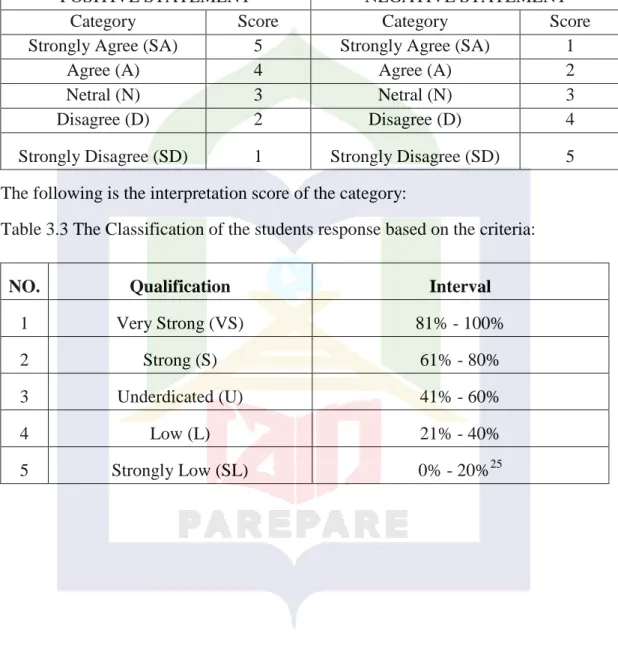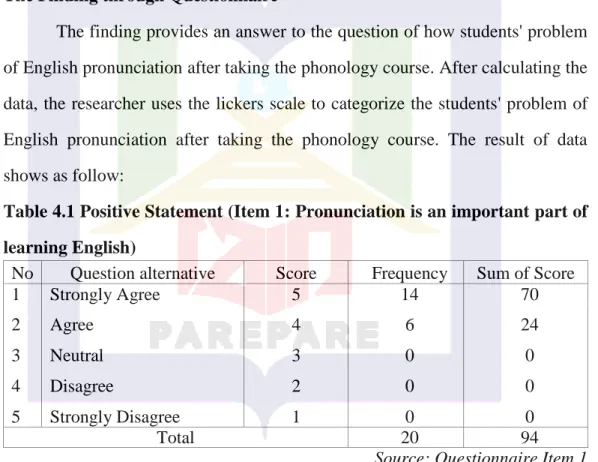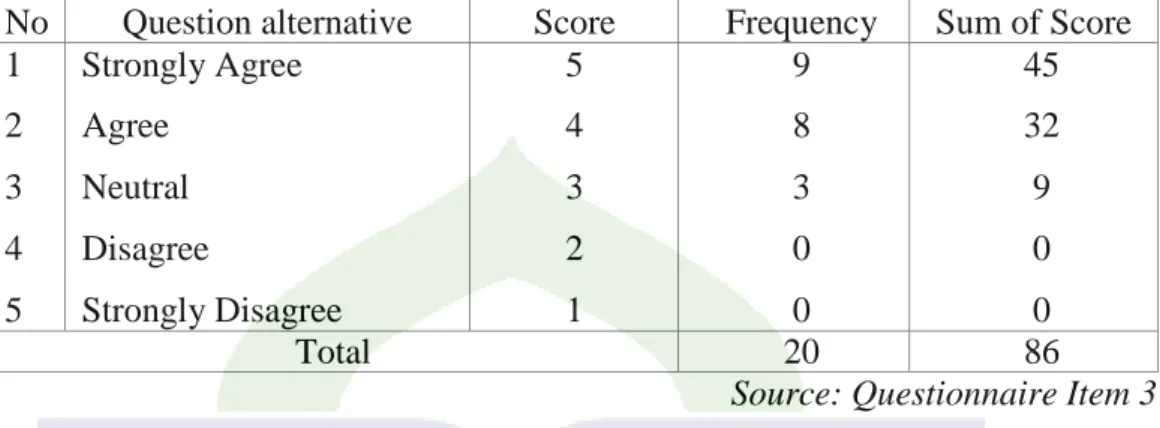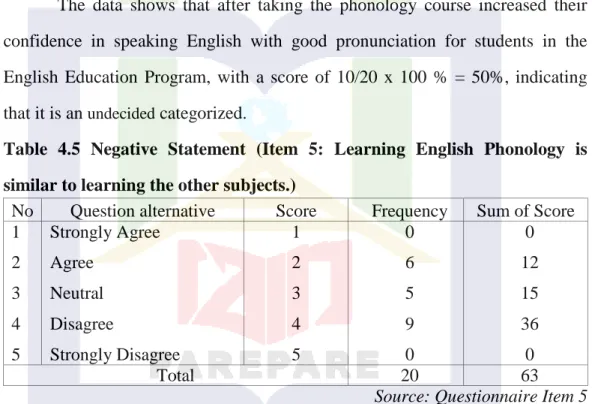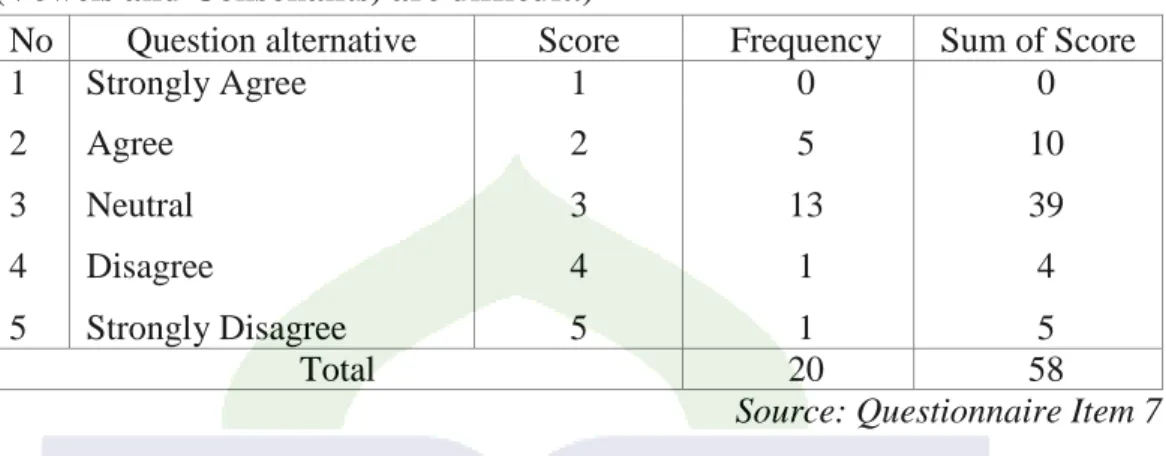Submitted to the English degree program at the Tarbiyah Faculty of State Islamic Institute of Parepare in partial fulfillment of the requirements for the degree of. All praise is to Allah, the Lord of the worlds, who gives the writer the strength and abilities to complete the final task of her study. Based on the researcher's results, the students consider phonology as a subject that can prevent the wrong pronunciation of the words in learning English, but they have been an undecided perspective in response to the statement that pronouncing the phonetic symbols (vowels and consonants) is difficult, it meant. Phonetic symbols are new learning for some students and sometimes confuse students when studying phonology.
FINDINGS AND DISCUSSION
CONCLUSION AND SUGGESTION
INTRODUCTION
- Background
- Research Question
- Objective of the Research
- Significance of the Research
What are the students' difficulties in English pronunciation after completing the phonology course of the students of the fourth semester of the English education program of IAIN Parepare. To describe the students' difficulties in English pronunciation after completing the phonology course in the student's fourth semester of the English education program IAIN Parepare. The result of the study can be used to know the students' problems in English pronunciation after taking the phonology course.
REVIEW OF RELATED LITERATUR
Previous Related Research Findings
Another supporting finding is the research conducted by Nazih Darojatin Ahsanah (Department of English Language Education IAIN Walisongo Semarang, 2013) titled "The Effect of Students' English Phonology Achievement on Their Pronunciation (Fourth Semester Study of English Language Education Department IAIN Walisongo Semarang in Study year 2012/2013". In addition, the researcher will focus on the student's perception of English pronunciation after they have completed the phonology course. 7Nazih Darojatin Ahsanah, "Effect of English Phonology Students' Achievement on Their Pronunciation (Fourth Semester Study of Department of English Language Education IAIN Walisongo Semarang during the academic year.
Some Pertinent Ideas 1. The Concept of Phonology
- Phonetics and Phonology
- Theory of English Vowels
- English Diphthong
- Consonant
- Difficulties in Learning Phonology
- The Concept of Pronunciation a) Definition of Pronunciation
- Conceptual Framework
Concerned with "the study of the physical properties of sounds and their place and mode of articulation in the vocal tract" Broughton et. The diphthong [aɪ], as in the words 'tide', 'time', 'pretty') begins with an open vowel, which is between front and back; it is quite similar to [ʌ] of the words 'cut' and 'bun'. Problems in learning the second language are mostly caused by differences in the linguistic systems of the two languages.
The Location and Duration of the Research
According to Anderson and Arsenault, research is a form of inquiry that explores phenomena in their natural setting and uses multi-methods to interpret, understand, explain and make sense of them.23 Based on McMillan and Schumacher's state, qualitative research describes and analyzes people's individual and collective social actions, beliefs, thoughts and perceptions. In addition, qualitative research is particularly effective in obtaining culturally specific information about the values, opinions, behavior and social contexts of certain population groups. 24.
Variable of the Research
Population and Sample 1. Population
Instrument of the Research
The purpose of the interview was to gain a deeper understanding of the students' opinions in the learning of pronunciation in the students' English education.
Procedure of Data Collection
Technique of Data Analysis
Data reduction means the process of selecting, identifying, classifying and coding data that are considered relevant. Based on the concept of data reduction, data reduction in this researcher what is the problem of students in English pronunciation after phonology course and the problems students face in learning phonology. Data visualization means the process of simplifying data in the form of a sentence or a table.
It may change if the researcher does not find strong evidence to support the next collection of data. But if the conclusion in the previous data can be proven by validity and consistency when the researcher has to return to the field, then the conclusion is credible. Briefly, the steps in analyzing the data are: (1) the researcher collects data through questionnaires and interviews.
The researcher then selects, identifies and focuses on the data with reference to the formulation of the research problem.

FINDING AND DISCUSSIONS
Findings
- The Finding through Questionnaire
- The Finding through Interview
Source: Item 2 of the questionnaire Table 4.2 shows that almost all students agree that learning pronunciation is not complete without learning phonology. We can assume that some students avoided mispronouncing English words after learning phonology. Source: Item 5 of the questionnaire. Table 4.5 shows that some students disagree with the statement that learning English phonology is similar to learning other subjects, which means that students gave a negative response when asked that learning phonology is similar to learning other English.
6 indicates that some of the students do not agree answer about the statement learning English Phonology is confusing for the students, it means that some of the students. The data shows that the learning of English phonology is confusing for the students in the English Education programme, with a score of 11/20 x indicating that it is categorized as undecided. Source: Questionnaire Item 10 Table 4.10 registers that almost all the students who accepted disagree about the statement that learning phonology is less useful to improve the quality of pronunciation, it can be seen where 15 (75%) students gave a positive answer have given that phonology courses can help improve the quality of their pronunciation.
Based on the interview result for the question “What have you gained after learning English phonology,” almost all students stated that they had learned and practiced how sounds are produced through the mouth during phonology class. After learning phonology, when the students asked: can you pronounce English words correctly, the students all answered “yes.” When the students were asked which parts of English pronunciation you find difficult to learn: Accent, Stress, Rhythm, Intonation or something else, almost all students said that Stress is a difficulty in learning pronunciation, which is perceived by the students experienced.
Based on the interview on how do you think phonology has an effect on English pronunciation, all the students refer to one answer: phonology has an effect on English pronunciation.

Discussion
Based on this research, the result of the students' questionnaires is the students' problem about English pronunciation after taking the phonology course in the students' fourth semester of the English education IAIN Parepare. It can be assumed that after learning phonology, some of the students had avoided mispronouncing English words. In point 5, some of the students disagree about the statement to learn English. Phonology is similar to learning other subjects, this meant that students responded negatively when asked if phonology learning is similar to other English learning.
In item 6, some students disagree with the answer about the statement that learning English phonology is confusing for students, which means that some students. In item 7, almost all students were undecided in response to the statement that the pronunciation of phonetic symbols (vowels and consonants) is difficult, which meant that phonetic symbols are a new learning for some students and sometimes confuse students when studying phonology. For item 8, almost all students agreed on the statement that learning phonetic symbols and articulation in phonology courses is the right system to improve pronunciation, which meant that studying phonology brought about changes in students' speaking abilities.
In point 9, almost all students disagreed with the statement that learning phonetic symbols (vowels, diphthongs and consonants) is not the right system. Based on the finding from the questionnaire about the student's problems in English pronunciation after taking the phonology course in the fourth semester of the students of the English education program IAIN Parepareit, it can be concluded that where the phonology lesson avoids them from wrong pronunciation of words. Students consider phonology as a subject that can prevent the wrong pronunciation of words in English learning, but they have been undecided in response to the statement that the pronunciation of phonetic symbols (vowels and consonants) is difficult, meaning that phonetic symbols are a new lesson for some students. and sometimes confuse students when studying phonology.
The researcher finds that the students studying English continue to make mistakes while pronouncing certain phonemes.
CONCLUSION AND SUGGESTION
Conclusions
Based on the finding of the second research problem, the researcher found the problem faced by students of the fourth semester of the English education program IAIN Parepare in learning phonology. To understand how students study English, which has a sound system that differs significantly from the language they master, namely Indonesian and regional languages, the first challenge they face is to pronounce the sound system of the language they are studying English. From the results of interviews that some English sounds do not exist in Indonesian sounds such as /v/, /ð/ and /θ/.
The researcher also found that students struggled with certain sounds that are separate phonemes in English but are not separate phonemes in Indonesian, such as short /I/ and /i:/ long sounds. Swan and Smith said that English learners from Indonesia often struggle to pronounce English has long and short vowel sounds such as / I / and / i: / in "bits" and "beats", but English learners in Indonesia often pronounce the two vowels out in the same way without any differences.
Suggestions
Learning English phonology is crucial in pronunciation and communication because if we fail to pronounce a word, it can make misunderstandings between speakers to a listener. The results of this research can be used by educators as supplementary information about what the students' problem faced when the students were learning phonology and pronunciation.
BIBLIOGRAPHY
Students' Pronunciation Awareness (A Case Study in the Islamic State Institute of English Students)”. English phonology towards their pronunciation (A study in the fourth semester of the Department of English Language Education of IAIN Walisongo Semarang in the academic year of. Attitudes and motivations in language learning: progress in theory, research and applications, in attitudes, orientation and Motivations in language learning.
APPENDICES
Saya mulai belajar bahasa Inggris di sekolah dasar dan belajar pengucapan di kelas dua sekolah menengah atas, sambil belajar fonologi di perguruan tinggi. Bagian mana dari pembelajaran fonologi dan pengucapan bahasa Inggris yang menurut Anda sulit dipelajari: (aksen, tekanan, ritme, intonasi atau lainnya). Ya, sejauh ini ada kata-kata bahasa Inggris yang bisa saya ucapkan dengan baik dan benar.
Karena jika kita melakukan kesalahan dalam pengucapan bahasa Inggris, orang akan salah paham dan bisa membuat kita malu. Saya mulai belajar bahasa Inggris di sekolah dasar dan menjadi akrab dengan pengucapan bahasa Inggris di sekolah menengah.
CURRICULUM VITAE
